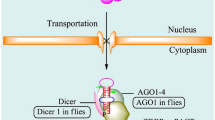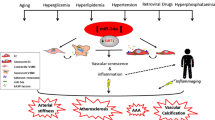Abstract
Aging is an important risk factor for the development of many cardiovascular diseases as atherosclerosis and is accompanied by the decline of endothelial function. Senescence of endothelial cells has been proposed to be involved in endothelial dysfunction and atherogenesis. Therefore, the study of new target therapies to prevent or reverse this process represents a field of great interest. MicroRNAs (miRNAs), a class of short RNAs, play key roles in various biological processes and in the development of human disease through specific posttranscriptional downregulation of gene expression. In particular, miRNAs that are highly expressed by endothelial cells can be detected in high concentration in human atherosclerotic plaques and in the circulation, suggesting their potential translation to bedside to determine the dysfunction of specific signaling pathways which play a role in coronary artery disease in the individual patient, a path towards a stratified medicine approach for early preventive treatment of disease. Here, we review the most recent advances in the field of atherosclerosis that implicate a role for miRNAs with a special emphasis on endothelial senescence and its involvement in the atherosclerotic process. Finally, we briefly discuss the potential use of miRNAs signatures to map atherosclerosis progression and in particular underlying the relevance of circulating plasma miRNAs that can be used clinically as biomarkers of vascular pathology.




Similar content being viewed by others
References
Davignon, J., & Ganz, P. (2004). Role of endothelial dysfunction in atherosclerosis. Circulation, 109, III27–III32.
Kim, V. N. (2005). MicroRNA biogenesis: coordinated cropping and dicing. Nature Reviews Molecular Cell Biology, 6, 376–385.
Krützfeldt, J., & Stoffel, M. (2006). MicroRNAs: a new class of regulatory genes affecting metabolism. Cell Metabolism, 4, 9–12.
Krützfeldt, J., Poy, M. N., & Stoffel, M. (2006). Strategies to determine the biological function of microRNAs. Nature Genetics, 38, S14–S19.
Vasudevan, S., Tong, Y., & Steitz, J. A. (2007). Switching from repression to activation: microRNAs can up-regulate translation. Science, 318, 1931–1934.
Minamino, T., & Komuro, I. (2007). Vascular cell senescence: contribution to atherosclerosis. Circulation Research, 100, 15–26.
Minamino, T., Miyauchi, H., Yoshida, T., Ishida, Y., Yoshida, H., & Komuro, I. (2002). Endothelial cell senescence in human atherosclerosis: role of telomere in endothelial dysfunction. Circulation, 105, 1541–1544.
Fridman, A. L., & Tainsky, M. A. (2008). Critical pathways in cellular senescence and immortalization revealed by gene expression profiling. Oncogene, 27, 5975–5987.
Gorospe, M., & Abdelmohsen, K. (2011). Microregulators come of age in senescence. Trends in Genetics, 27, 233–241.
Kuehbacher, A., Urbich, C., Zeiher, A. M., & Dimmeler, S. (2007). Role of Dicer and Drosha for endothelial microRNA expression and angiogenesis. Circulation Research, 101, 59–68.
Suárez, Y., Fernández-Hernando, C., Pober, J. S., & Sessa, W. C. (2007). Dicer dependent microRNAs regulate gene expression and functions in human endothelial cells. Circulation Research, 100, 1164–1173.
Ji, R., Cheng, Y., Yue, J., Yang, J., Liu, X., Chen, H., et al. (2007). MicroRNA expression signature and antisense-mediated depletion reveal an essential role of microRNA in vascular neointimal lesion formation. Circulation Research, 100, 1579–1588.
Weber, C., & Noels, H. (2011). Atherosclerosis: current pathogenesis and therapeutic options. Nature Medicine, 17, 1410–1422.
Kong, W., Zhao, J. J., He, L., & Cheng, J. Q. (2009). Strategies for profiling microRNA expression. Journal of Cellular Physiology, 218, 22–25.
Menghini, R., Casagrande, V., Cardellini, M., Martelli, E., Terrinoni, A., Amati, F., et al. (2009). MicroRNA 217 modulates endothelial cell senescence via silent information regulator 1. Circulation, 120, 1524–1532.
Ito, T., Yagi, S., & Yamakuchi, M. (2010). MicroRNA-34a regulation of endothelial senescence. Biochemical and Biophysical Research Communications, 398, 735–740.
Haigis, M. C., & Guarente, L. P. (2006). Mammalian sirtuins-emerging roles in physiology, aging, and calorie restriction. Genes & Development, 20, 2913–2921.
Mattagajasingh, I., Kim, C. S., Naqvi, A., Yamamori, T., Hoffman, T. A., Jung, S. B., et al. (2007). SIRT1 promotes endothelium-dependent vascular relaxation by activating endothelial nitric oxide synthase. Proceedings of the National Academy of Sciences of the United States of America, 104, 14855–14860.
Langley, E., Pearson, M., Faretta, M., Bauer, U. M., Frye, R. A., Minucci, S., et al. (2002). Human SIR2 deacetylates p53 and antagonizes PML/p53-induced cellular senescence. EMBO Journal, 21, 2383–2396.
Alcendor, R. R., Gao, S., Zhai, P., Zablocki, D., Holle, E., Yu, X., et al. (2007). Sirt1 regulates aging and resistance to oxidative stress in the heart. Circulation Research, 100, 1512–1521.
Vasa-Nicotera, M., Chen, H., Tucci, P., Yang, A. L., Saintigny, G., Menghini, R., et al. (2011). MiR-146a is modulated in human endothelial cell with aging. Atherosclerosis, 217, 326–330.
LaRocca, T. J., Henson, G. D., Thorburn, A., Sindler, A. L., Pierce, G. L., & Seals, D. R. (2012). Translational evidence that impaired autophagy contributes to arterial ageing. Journal de Physiologie, 590, 3305–3316.
Gibbings, D., Mostowy, S., Jay, F., Schwab, Y., Cossart, P., & Voinnet, O. (2012). Selective autophagy degrades DICER and AGO2 and regulates miRNA activity. Nature Cell Biology, 14, 1314–1321.
Lee, I. H., Cao, L., Mostoslavsky, R., Lombard, D. B., Liu, J., Bruns, N. E., et al. (2008). A role for the NAD-dependent deacetylase Sirt1 in the regulation of autophagy. Proceedings of the National Academy of Sciences of the United States of America, 105, 3374–3379.
Federici, M., Hribal, M. L., Menghini, R., Kanno, H., Marchetti, V., Porzio, O., et al. (2005). Timp3 deficiency in insulin receptor-haploinsufficient mice promotes diabetes and vascular inflammation via increased TNF-alpha. The Journal of Clinical Investigation, 115, 3494–3505.
Menghini, R., Menini, S., Amoruso, R., Fiorentino, L., Casagrande, V., Marzano, V., et al. (2009). Tissue inhibitor of metalloproteinase 3 deficiency causes hepatic steatosis and adipose tissue inflammation in mice. Gastroenterology, 136, 663–672.
Cardellini, M., Menghini, R., Luzi, A., Davato, F., Cardolini, I., D’Alfonso, R., et al. (2011). Decreased IRS2 and TIMP3 expression in monocytes from offspring of type 2 diabetic patients is correlated with insulin resistance and increased intima–media thickness. Diabetes, 60, 3265–3270.
Casagrande, V., Menghini, R., Menini, S., Marino, A., Marchetti, V., Cavalera, M., et al. (2012). Overexpression of tissue inhibitor of metalloproteinase 3 in macrophages reduces atherosclerosis in low-density lipoprotein receptor knockout mice. Arteriosclerosis, Thrombosis, and Vascular Biology, 32, 74–81.
Menghini, R., Casagrande, V., Menini, S., Marino, A., Marzano, V., Hribal, M. L., et al. (2012). TIMP3 overexpression in macrophages protects from insulin resistance, adipose inflammation, and nonalcoholic fatty liver disease in mice. Diabetes, 61, 454–462.
Fiorentino, L., Cavalera, M., Menini, S., Marchetti, V., Mavilio, M., Fabrizi, M., et al. (2013). Loss of TIMP3 underlies diabetic nephropathy via FoxO1/STAT1 interplay. EMBO Molecular Medicine, 5, 441–455.
Cardellini, M., Menghini, R., Martelli, E., Casagrande, V., Marino, A., Rizza, S., et al. (2009). TIMP3 is reduced in atherosclerotic plaques from subjects with type 2 diabetes and increased by SirT1. Diabetes, 58, 2396–2401.
Greco, S., Fasanaro, P., Castelvecchio, S., D’Alessandra, Y., Arcelli, D., Di Donato, M., et al. (2012). MicroRNA dysregulation in diabetic ischemic heart failure patients. Diabetes, 61, 1633–1641.
Wang, S., Aurora, A. B., Johnson, B. A., Qi, X., McAnally, J., Hill, J. A., et al. (2008). The endothelial-specific microRNA miR-126 governs vascular integrity and angiogenesis. Developmental Cell, 15, 261–271.
Harris, T. A., Yamakuchi, M., Ferlito, M., Mendell, J. T., & Lowenstein, C. J. (2008). MicroRNA-126 regulates endothelial expression of vascular cell adhesion molecule 1. Proceedings of the National Academy of Sciences of the United States of America, 105, 1516–1521.
Bonauer, A., Carmona, G., Iwasaki, M., Mione, M., Koyanagi, M., Fischer, A., et al. (2009). MicroRNA-92a controls angiogenesis and functional recovery of ischemic tissues in mice. Science, 324, 1710–1713.
Fang, Y., & Davies, P. F. (2012). Site-specific microRNA-92a regulation of Kruppel-like factors 4 and 2 in atherosusceptible endothelium. Arteriosclerosis, Thrombosis, and Vascular Biology, 32, 979–987.
Sabatel, C., Malvaux, L., Bovy, N., Deroanne, C., Lambert, V., Gonzalez, M. L., et al. (2011). MicroRNA-21 exhibits antiangiogenic function by targeting RhoB expression in endothelial cells. PLoS One, 6, e16979.
Zhou, J., Wang, W. W., Subramaniam, S., Shyy, J. Y., Chiu, J. J., Li, J. Y., et al. (2011). MicroRNA-21 targets peroxisome proliferators-activated receptor-α in an autoregulatory loop to modulate flow-induced endothelial inflammation. Proceedings of the National Academy of Sciences of the United States of America, 108, 10355–10360.
Chen, L. J., Lim, S. H., Yeh, Y. T., Lien, S. C., & Chiu, J. J. (2012). Roles of microRNAs in atherosclerosis and restenosis. Journal of Biomedical Science, 19, 79.
Raitoharju, E., Lyytikäinen, L. P., Levula, M., Oksala, N., Mennander, A., Tarkka, M., et al. (2011). MiR-21, miR-210, miR-34a, and miR-146a/b are up-regulated in human atherosclerotic plaques in the Tampere Vascular Study. Atherosclerosis, 219, 211–217.
Li, T., Cao, H., Zhuang, J., Wan, J., Guan, M., Yu, B., et al. (2011). Identification of miR-130a, miR-27b and miR-210 as serum biomarkers for atherosclerosis obliterans. Clinica Chimica Acta, 412, 66–70.
Takahashi, Y., Satoh, M., Minami, Y., Tabuchi, T., Itoh, T., & Nakamura, M. (2010). Expression of miR-146a/b is associated with the Toll-like receptor 4 signal in coronary artery disease: effect of renin-angiotensin system blockade and statins on miRNA-146a/b and Toll-like receptor 4 levels. Clinical Science (London, England), 119, 395–405.
Guo, M., Mao, X., Ji, Q., Lang, M., Li, S., Peng, Y., et al. (2010). MiR-146a in PBMCs modulates Th1 function in patients with acute coronary syndrome. Immunology and Cell Biology, 88, 555–564.
Du, F., Zhou, J., Gong, R., Huang, X., Pansuria, M., Virtue, A., et al. (2012). Endothelial progenitor cells in atherosclerosis. Frontiers in Bioscience, 17, 2327–2349.
Zhang, Q., Kandic, I., & Kutryk, M. J. (2011). Dysregulation of angiogenesis-related microRNAs in endothelial progenitor cells from patients with coronary artery disease. Biochemical and Biophysical Research Communications, 405, 42–46.
Zhao, T., Li, J., & Chen, A. F. (2010). MicroRNA-34a induces endothelial progenitor cell senescence and impedes its angiogenesis via suppressing silent information regulator 1. American Journal of Physiology, Endocrinology and Metabolism, 299, E110–E116.
Zernecke, A., Bidzhekov, K., Noels, H., Shagdarsuren, E., Gan, L., Denecke, B., et al. (2009). Delivery of microRNA-126 by apoptotic bodies induces CXCL12-dependent vascular protection. Science Signaling, 2, ra81.
Hunter, M. P., Ismail, N., Zhang, X., Aguda, B. D., Lee, E. J., Yu, L., et al. (2008). Detection of microRNA expression in human peripheral blood microvesicles. PLoS One, 3, e3694.
Zampetaki, A., Kiechl, S., Drozdov, I., Willeit, P., Mayr, U., Prokopi, M., et al. (2010). Plasma microRNA profiling reveals loss of endothelial miR-126 and other microRNAs in type 2 diabetes. Circulation Research, 107, 810–817.
Fichtlscherer, S., De Rosa, S., Fox, H., Schwietz, T., Fischer, A., Liebetrau, C., et al. (2010). Circulating microRNAs in patients with coronary artery disease. Circulation Research, 107, 677–684.
Yao, R., Ma, Y., Du, Y., Liao, M., Li, H., Liang, W., et al. (2011). The altered expression of inflammation-related microRNAs with microRNA-155 expression correlates with Th17 differentiation in patients with acute coronary syndrome. Cellular and molecular immunology, 8, 486–495.
Wang, H., Lu, H. M., Yang, W. H., Luo, C., Lu, S. H., Zhou, Y., et al. (2012). The influence of statin therapy on circulating microRNA-92a expression in patients with coronary heart disease. Zhongguo Wei Zhong Bing Ji Jiu Yi Xue, 24, 215–218.
Nazari-Jahantigh, M., Wei, Y., Noels, H., Akhtar, S., Zhou, Z., Koenen, R. R., et al. (2012). MicroRNA-155 promotes atherosclerosis by repressing Bcl6 in macrophages. The Journal of Clinical Investigation, 122, 4190–4202.
Author information
Authors and Affiliations
Corresponding author
Additional information
Associate Editor Enrique Lara-Pezzi oversaw the review of this article
Rights and permissions
About this article
Cite this article
Menghini, R., Casagrande, V. & Federici, M. MicroRNAs in Endothelial Senescence and Atherosclerosis. J. of Cardiovasc. Trans. Res. 6, 924–930 (2013). https://doi.org/10.1007/s12265-013-9487-7
Received:
Accepted:
Published:
Issue Date:
DOI: https://doi.org/10.1007/s12265-013-9487-7




